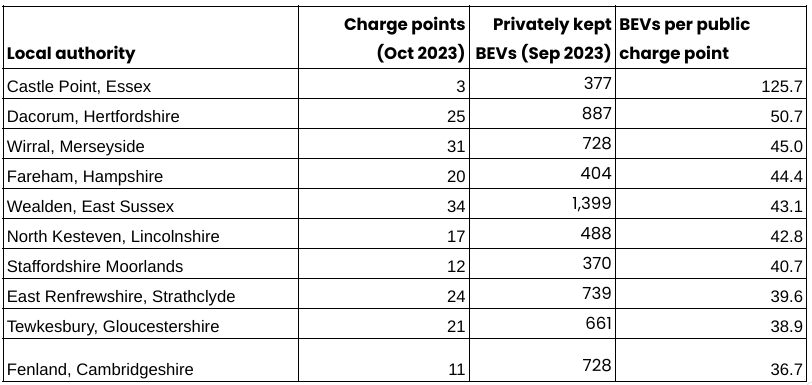Twenty yards behind - chargepoint winners and losers
These men are unhappy about public charge point provision in their borough
Gov.uk published its latest quarterly report on public charge point rollout at the end of last month. Amongst the doom and gloom on EV sales (up 42,000 in the year to March 2024 on the previous 12 months, purchase costs down, savings of £1000 a year on running costs, that kind of thing), it’s good to hear that it hasn’t damaged charge point operator confidence.
Amongst the headlines, total charge point numbers are up 49% on the past year, whilst rapid chargers (50KW and above) are up 30% in just the past 6 months (when Government changed the way it categorised the data).
But this blog isn’t about that. Instead we zoom in on the worst areas for public charge point provision - looking at where performance is improving, which areas continue to lag, and what Whitehall can usefully do to spur action on charge points in town halls - as well as what might be a distraction.
Gov.uk’s own data - and much of the media commentary - tends to focus on charge points per 100,000 people, but this is inappropriate as a guide as EVs are not evenly distributed around the country. Instead this approach compares public charge points and actual EV numbers, taken from elsewhere on gov.uk.
Caveats part 1 - the vehicle registration data is from September 2023, the most recent available, and only includes privately held battery electric vehicles, because company held vehicles are registered to the company’s location, rather than where the vehicle is actually being driven. It doesn’t take account of plug-in hybrids, which are much more likely to be charged at home.
Caveats part 2 - The ratio of charge points to EV is not the whole story. Norway has fewer EVs per chargepoint but 83% of its car sales are EVs, compared with 17% here. Areas with limited off-street parking - London, other very densely populated areas - are expected to have more public charge point provision, because they have very limited off-street parking and therefore fewer opportunities to charge at home. More on this in our blog Everything everywhere all at once.
Here are the results - to show how the results evolve over time, we start with the worst performing 10 councils on October 2023 data.
So the poorest provision is not generally in metropolitan areas of the north, where charge point rollout is often compared unfavourably with London. 6 of the worst 10 areas are actually in the south and east. Sure, these areas will have more off-street parking than those metropolitan areas, but people live in flats there too, and they have significantly fewer chargers than neighbouring districts. Taking Fareham as an example, 10 of the 11 other districts in Hampshire have more than twice as many chargers per EV, and the other comparative laggard, East Hampshire, has one-third more.
The worst local authority on this measure - Castle Point, which takes in Canvey Island, home of petrochemicals, dashing 70s pub rockers Dr Feelgood (pictured above) and some lovely nature reserves - is doing more than twice as badly as the second poorest performer, Staffordshire Moorlands.
Let’s fast forward to the most recent data release, which shows some significant changes.
Only 3 councils - Fareham, Staffordshire Moorlands and Castle Point - are still in the bottom 10. The other councils which were previously at the bottom have piled on charge points in the intervening 6 months, with Tewkesbury and Dacorum increasing numbers by around two-thirds, Wirral by 90% and Wealden more than doubling its charge point provision.
So not every local authority with current weak provision is a persistent laggard - projects take time to come on stream, hitches occur with grid connections and the permitting process remains time-consuming.
Labour is talking about binding chargepoint targets for all local authorities, whilst the Conservatives have spoken for a while about taking powers for the Government to issue instructions to local authorities, but have yet to do so.
It’s unclear that binding targets are necessary - Wirral and Wealden haven’t needed them to make progress. And the process of taking account of all the factors, including the availability of charging on driveways, on-street via gullies and at workplaces (none of which are now being robustly counted) may prove a distraction for central Government and local authority alike.
Would it have sped up or slowed down the rollout of chargepoints in these districts if local government staff were taken off the process of negotiating and agreeing chargepoint installations to write a strategy on what they were about to do before they were interrupted by central Government?
After all, of the 360 local authorities in the dataset, the majority are doing well, and most of the rest are doing OK. But clearly some councils are struggling. Castle Point last installed a charge point in April 2021. Since then the number of EVs registered in the district has tripled. The Borough Council website reveals no councillors frothing against new technologies or blocking charge points to stop hard-touring pub rockers from making the switch. Indeed Essex County Council has an EV charge point strategy and the initial community and stakeholder engagement on the Castle Point plan speaks warmly of electric vehicles and charge point provision.
But one can’t help a sneaking suspicion that something is amiss here, and potentially in Staffordshire Moorlands and Fareham too. Statutory powers to direct appear to be needed here, and Government should be getting on with organising them. However the lack of them should not be preventing Ministers and Department for Transport officials from picking up the phone and asking what on earth is going on.



